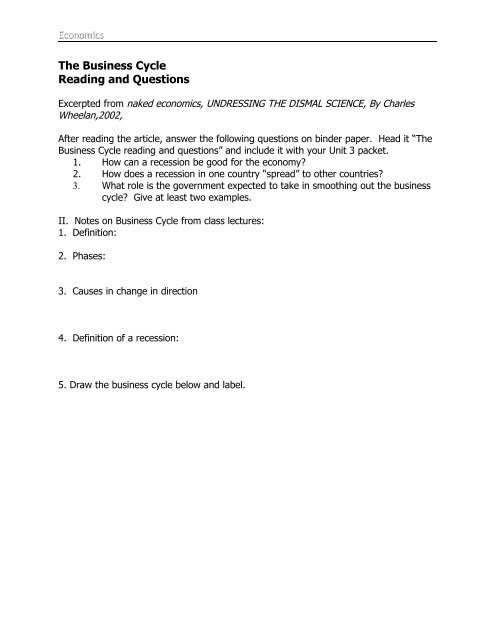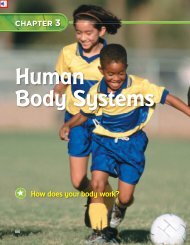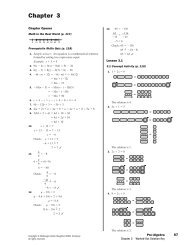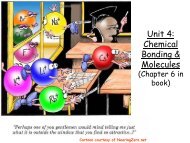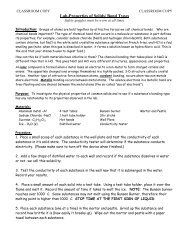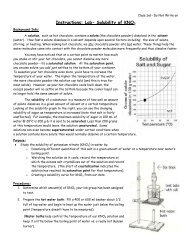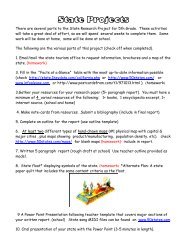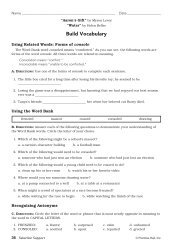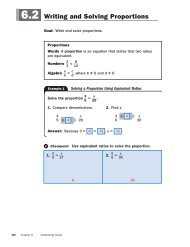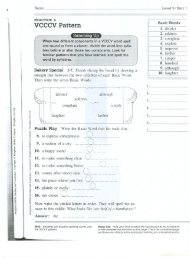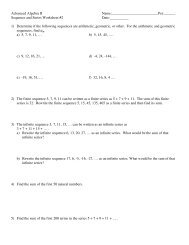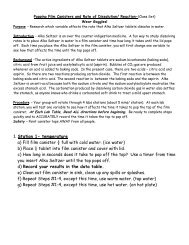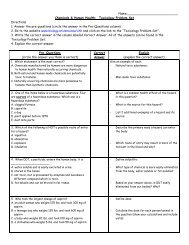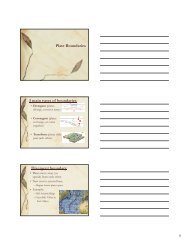You also want an ePaper? Increase the reach of your titles
YUMPU automatically turns print PDFs into web optimized ePapers that Google loves.
Economics<br />
<strong>The</strong> <strong>Business</strong> <strong>Cycle</strong><br />
Reading and Questions<br />
Rocklin High School<br />
Excerpted from naked economics, UNDRESSING THE DISMAL SCIENCE, By Charles<br />
Wheelan,2002,<br />
After reading the article, answer the following questions on binder paper. Head it “<strong>The</strong><br />
<strong>Business</strong> <strong>Cycle</strong> reading and questions” and include it with your Unit 3 packet.<br />
1. How can a recession be good for the economy?<br />
2. How does a recession in one country “spread” to other countries?<br />
3. What role is the government expected to take in smoothing out the business<br />
cycle? Give at least two examples.<br />
II. Notes on <strong>Business</strong> <strong>Cycle</strong> from class lectures:<br />
1. Definition:<br />
2. Phases:<br />
3. Causes in change in direction<br />
4. Definition of a recession:<br />
5. Draw the business cycle below and label.
Economics<br />
Rocklin High School<br />
Every four years men from far and wide cast their hats into the national ring of electoral<br />
politics and compete for the job of President of the United States of America. Each time<br />
this process occurs the nation appears to go through serious soul searching. We<br />
debate, we poll, we campaign and we fund raise. In November the American people,<br />
after listening to this great public discourse (please note my sarcasm here!), elect a<br />
President. Well, some will say the most important issue may be foreign policy or<br />
character or the amount of money in a candidate war chest but there is really only one<br />
thing that most Americans really care about... the economy.<br />
If history tells us anything it is that when times are good political parties and candidates<br />
stand a very good chance of being reelected and when times are bad the incumbent<br />
had better start packing his bags for whatever state he came from. Hearken back to the<br />
immortal words spoken by then candidate William Jefferson Clinton in a debate versus<br />
incumbent George Herbert Walker Bush when asked what the most important issue in<br />
the election was: "It's the economy, stupid." Clinton had his finger on the pulse of the<br />
nation (no pun intended), Bush did not and thus Bush lost.<br />
While presidents appear to take much of the blame and accolades for the success and<br />
failure of the economy, this is not quite fair. History shows us that the economy is<br />
cyclical in nature. Take a look at the chart below as an example of the ups and downs of<br />
the American economy.<br />
As you can see by even a cursory examination of the graph there have been periods of<br />
great productivity as well as growth. In general you can note that we have had our ups<br />
and downs. I am sure what jumps out at you is the Great Depression. This chart really<br />
shows how low productivity really was and how little spending was going on. Of course<br />
this was followed by huge government spending on World War II that essentially got us<br />
out of the Depression.<br />
Further examination notes that almost every time there is a war, our economy's<br />
productivity and spending go up to correspond to the wartime spending. You can also<br />
note typical post war declines.<br />
You should also pay attention to the longest period of continued economic growth and<br />
prosperity. My interpretation shows either W.W.II or Vietnam as the longest sustained<br />
growth and that was buoyed by wartime spending. Either way the longest period would<br />
be 2 to 4 years tops. Now figure this, since 1992, the end of the graph, our production
Economics<br />
Rocklin High School<br />
has risen every year. That puts us smack in the middle of the longest period of<br />
sustained economic growth in our nation’s history. It’s now 9 years and shows no<br />
immediate signs of slowing down. History and graphs tell us, however, that it has to end<br />
sometime; the question is... when?<br />
THE PHASES OF THE BUSINESS CYCLE<br />
Economists have certain ways of labeling the business cycle. <strong>The</strong> business cycle may<br />
be defined as the changes that occur to the real GDP because of alternating periods of<br />
expansion and contraction. <strong>The</strong> phases are:<br />
1. Recession. A decline in the real GDP that occurs for at least two or more quarters.<br />
Recessions feed on themselves. During a recession, business people spend less than<br />
they once did. Because sales are failing, businesses do what they can to reduce their<br />
spending. <strong>The</strong>y lay off workers, buy less merchandise, and postpone plans to expand.<br />
When this happens, business suppliers do what they can to protect themselves. <strong>The</strong>y<br />
too lay off workers and reduce spending.<br />
As workers earn less, they spend less, and business income and profits decline still<br />
more. <strong>Business</strong>es spend even less than before and lay off still more workers. <strong>The</strong><br />
economy continues to slide.<br />
2. Low Point, or Depression. State of the economy where there are large<br />
unemployment rates, a decline in annual income, and overproduction. <strong>The</strong> time at which<br />
the real GDP stops its decline and starts expanding; the lowest point. Sooner or later,<br />
the recession will reach the bottom of the business cycle. How long the cycle will remain<br />
at this low point varies from a matter of weeks to many months. During some<br />
depressions, such as the one in the 1930s, the low point has lasted for years.<br />
3. Expansion and Recovery. A period in which the real GDP grows; recovery from a<br />
recession. When business begins to improve a bit, firms will hire a few more workers<br />
and increase their orders of materials from their suppliers. Increased orders lead other<br />
firms to increase production and rehire workers. More employment leads to more<br />
consumer spending, further business activity, and still more jobs. Economists describe<br />
this upturn in the business cycle as a period of expansion and recovery.<br />
4. Peak. <strong>The</strong> point at which the real GDP stops increasing and begins its decline; the<br />
highest point. At the top, or peak, of the business cycle, business expansion ends its<br />
upward climb. Employment, consumer spending, and production hit their highest levels.<br />
A peak, like a depression, can last for a short or long period of time. When the peak<br />
lasts for a long time, we are in a period of prosperity.<br />
One of the dangers of peak periods is that of inflation. During periods of inflation, prices<br />
rise and the value of money declines. Inflation is more of a threat during peak periods<br />
because employment and earnings are at high levels. With more money in their<br />
pockets, people are willing to spend more than before. In this way, demand is increased<br />
and prices rise.


